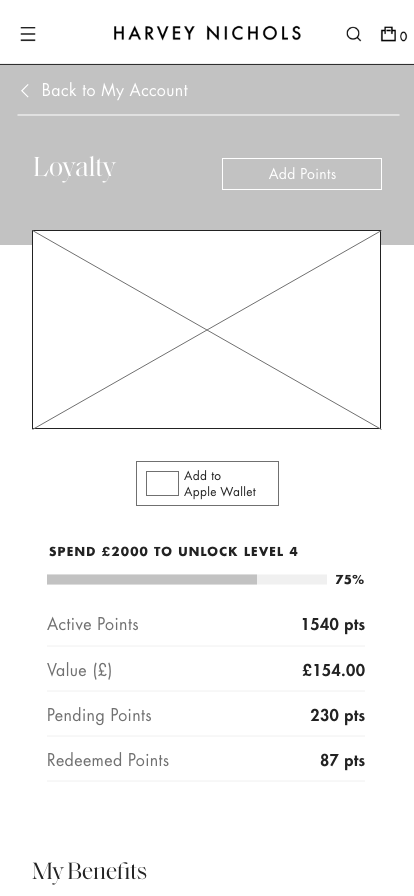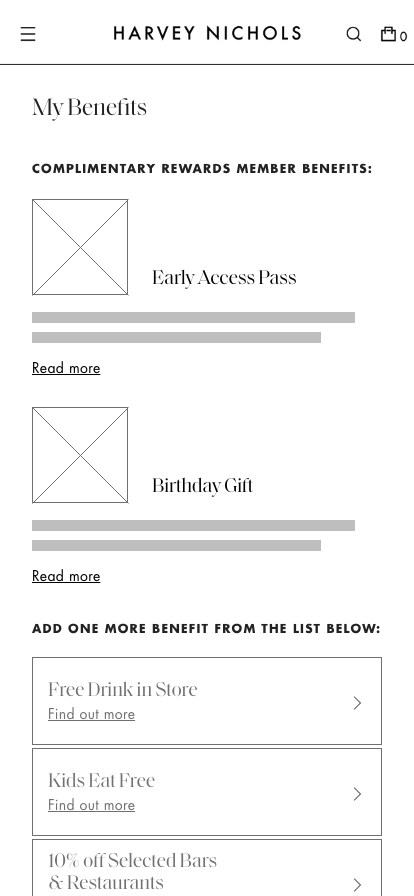Why is loyalty important?
The primary motive behind a loyalty programme is to retain customers by rewarding them for their repeat purchase behavior. Repeat customers are 9 times more likely to convert than first-time shoppers. Moreover, repeat customers are more likely to return with each purchase:
“77% of shoppers say a loyalty programme make it more likely they will make additional purchases with a brand"
We already have rewards, why do we need to relaunch it?
Business Pain Points
The program was underperforming: in 2018/19, only 42% of total sales came from Rewards members, compared to 90% at leading competitors.
International expansion was not possible with the existing technology.
Managing rewards required a huge amount of manual work, leading to inefficiency and frequent errors.
The system could not run tactical campaigns, promotions, or adapt to changing business goals.
The program did not meet basic industry standards for loyalty, such as resetting points, moving customers between tiers, or running special point events.
User Pain Points
Customers found rewards confusing and slow to redeem. Many expected instant rewards, but the process was complicated and unclear.
Users often visited the FAQ or needed help from staff just to understand how the program worked.
Store staff struggled to explain or promote the program because it was not intuitive for them either.
Personalisation was missing, users expect rewards based on their habits, not just transactions.
Loyalty was only accessible in the app, but many customers didn’t want another app taking up phone space.
Competitors
Competitor analysis helps Harvey Nichols refine customer experiences by benchmarking industry leaders like Matches Fashion and Harrods. By examining their loyalty programs, tiers, and benefits, we identify trends, gaps, and opportunities to innovate and deliver a seamless, luxury experience that sets us apart.
User Requirements and Prioritization
To guide our priorities, we adopted a value versus effort matrix. This approach helped us focus on solutions that would make the biggest difference for users while minimising complexity for the business. Not every feature request or idea is equal, so we used the matrix to clarify what to build next. Features that offer high value for users and low effort for the business are immediate priorities. High value and high effort ideas are carefully evaluated for future phases, while low value, high effort suggestions are deprioritised. This process kept both the product and design teams aligned and ensured our roadmap remained user-centered and practical.
Updated Rewards Tier Structure
Following user feedback and stakeholder input, we introduced a refined five-tier rewards system to replace the previous offering. The new structure delivers greater clarity, a stronger sense of exclusivity and benefit, and increased incentive to progress through the tiers.
User Journeys
At Harvey Nichols, analysing the rewards journey helped us understand and improve the experiences of registered and non-registered users. By identifying gaps and simplifying sign-ups and reward access, we created a seamless, engaging journey that reflected our premium service.
Wireframe (Low-fi)
I created a wireframe to clarify the layout for the "Rewards" page in My Account before moving into the high-fidelity mockup stage. This wireframe served as a foundational sketch, outlining the structure and placement of key elements such as menus, navigation bars, rewards cards, and other interactive components. It was designed to provide a clear visual guide for how users would interact with the page, ensuring a seamless and intuitive experience.
Usability Testing
Usability testing is a method used to evaluate a product by observing how real users interact with it. For this session, the goal was to assess the ease of registering as a loyalty member and managing benefits within the new "My Account" design. Testing scenarios included:
New user: No Harvey Nichols account or rewards
Existing account, no rewards: Has an account but not in the rewards program
Existing account with rewards: Already enrolled in the rewards program
This process surfaced key pain points, informed product decisions, and improved alignment with user needs and expectations.
New User - First-Time Loyalty Registration
Key Findings
Benefit selection was clear and easy
Progress indicator boosted user confidence
Uncertainty about whether selections were final
Actions Taken
Added a confirmation step before locking in choices
Included unique illustrations for each benefit to provide instant clarity and support understanding
Existing Account, No Rewards - Joining Loyalty
Key Findings
Dashboard clearly prompted users to join and select benefits
Benefit descriptions supported confident decisions
No way to review past selections
Actions Taken
Added benefit history to the dashboard
Improved visual distinction between active and inactive benefits
Existing Account with Rewards - Managing Benefits
Key Findings
Comparing benefits was simple
My Benefits summary was helpful for quick access
Lock-in deadlines and new benefits were easy to miss
Actions Taken
Added persistent deadline reminders
Highlighted new and unlocked benefits in the dashboard
Mockup (High-fi)
During the wireframing stage, I conducted multiple meetings with stakeholders and engineers across the business to gather feedback and understand technical and business limitations. This collaborative approach allowed us to ensure alignment and feasibility early in the process.
As the design evolved, I translated the collected ideas into mockups, incorporating all necessary design components to provide a realistic representation of the product. Leveraging the Harvey Nichols design system, I applied UI elements consistently, ensuring adherence to brand guidelines and creating a cohesive user experience.
Wrapping Up
The Harvey Nichols Rewards program redesign provided key insights into user-centered design. Understanding user needs, simplifying processes, and addressing diverse scenarios were essential in creating a seamless experience. Regular testing and clear communication helped refine the program and build trust. These lessons will continue to shape future projects, ensuring thoughtful, user-friendly designs.
35%
Increase in Engagement
More users interacted with the Rewards program post-redesign.
60%
Fewer Errors
Usability improvements reduced user-reported issues significantly.
25%
Higher Retention
Enhanced experience led to stronger customer loyalty.





























